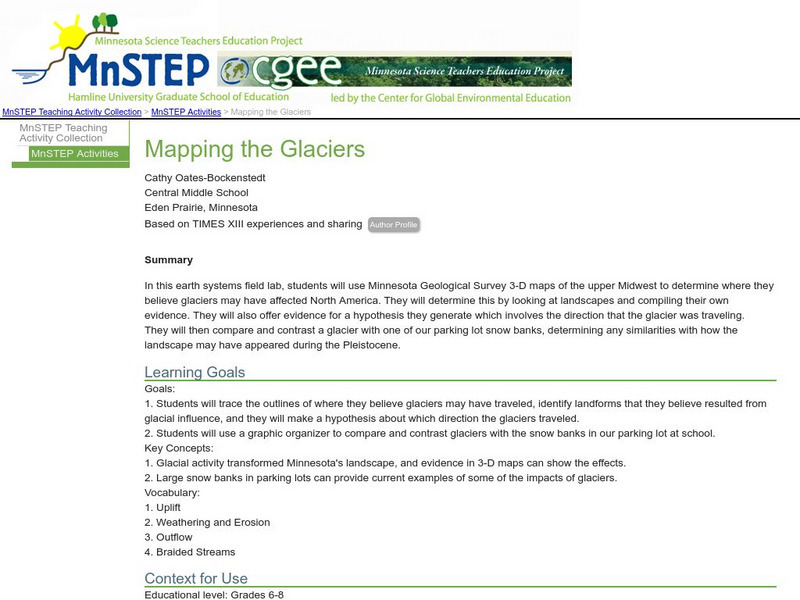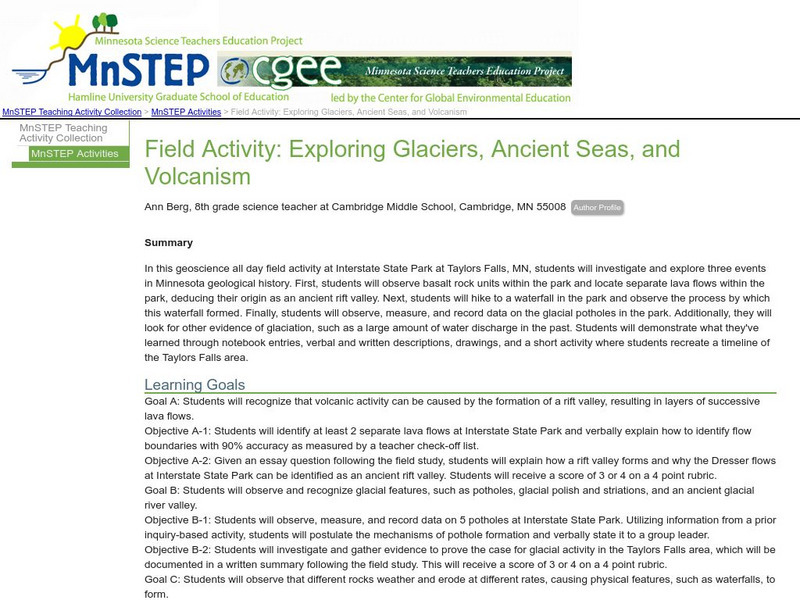Curated OER
Climate Change: What's Hot? What's Happening?
Students conduct a web-based project to analyze recent or on-going climate change research in the North. They are exposed to the application of science in current research on climate change.
Discovery Education
Discovery Education: Glaciers and Icebergs
A lesson plan for simulating glacial scraping with extensions that investigate iceberg towing and iceberg melting.
Science Education Resource Center at Carleton College
Serc: Mapping the Glaciers
In this activity, learners will use Minnesota Geological Survey 3-D maps of the upper Midwest to trace the outlines of where they believe glaciers may have affected North America. They will identify landforms that resulted from glacial...
University Corporation for Atmospheric Research
Ucar: Little Ice Age: Where Have All the Glaciers Gone?
In this lesson, young scholars examine images of alpine glaciers to develop an under-standing of how glaciers respond to climate change.
National Earth Science Teachers Association
Windows to the Universe: Changing Planet: Melting Glaciers
Students sort photographs of glaciers and measure glacial retreat to observe how alpine glaciers have retreated over the past century. Includes a printable worksheet, links to relevant materials, and extension activities.
University Corporation for Atmospheric Research
Ucar: Glaciers Then and Now
Students compare photographs of glaciers to observe how Alaskan glaciers have changed over the last century.
Science Education Resource Center at Carleton College
Serc: Ice Cream Model How Glaciers Formed the Minnesota Landscape
This classroom demonstration using ice cream illustrates to students the effects that the glaciers had on Minnesota's landscape.
Science Education Resource Center at Carleton College
Serc: Glaciers in Our Own Backyard
Learners identify glacial activity and infer how those events shape the area. This lesson involves a filed trip to a location where it is possible to examine glacial events.
Science Education Resource Center at Carleton College
Serc: Mn Step: Sinking Water: Glaciers, Ocean Currents and Weather Patterns
A lesson where students learn how warm water is less dense than cold water, and what this means for global climate change as ice from the polar regions melts. Students will do experiments in buoyancy and water density when hot or cold,...
Science Education Resource Center at Carleton College
Serc: Field Activity: Exploring Glaciers, Ancient Seas, and Volcanism
In this geoscience all day field activity at Interstate State Park at Taylors Falls, MN, young scholars investigate and explore three events in Minnesota geological history.
Science Education Resource Center at Carleton College
Serc: Geologic Stories: Retreating Waterfalls and Fossils
A geology field investigation where learners investigate fossiliferous limestone, the study local stratigraphy, and understand how glaciers and rivers have shaped the community.
Utah Education Network
Uen: Move It!
Fourth graders explore the erosive effects of waves, streams, glaciers, and wind.
PBS
Nova: Extreme Ice
Students study how scientists monitor changes in Earth's glaciers, ice caps, and ice sheets. They investigate about glacier locations, glacial movement, and impacts of climate change on glaciers depending on the depth of research.
Climate Literacy
Clean: Sea Level Rise
Students will learn the difference between sea ice and glaciers in relation to sea level rise using topographic maps.
Other
Personal Website: Richard Treves: Lesson Plans
Study climate change with Google Earth, explore glaciers in the Himalayas, and learn how to avoid lava destroying a home in Hawaii with these three expert-developed lesson plans.
American Geosciences Institute
American Geosciences Institute: Earth Science Week: Glacier Slide
Students describe how a glacier carves land and label the characteristics formed by the glacier's movement.
Illustrative Mathematics
Illustrative Mathematics: S cp.a.4, S cp.a.5 and S cp.b.6: The Titanic 3
On April 15, 1912, the Titanic struck an iceberg and rapidly sank with only 710 of her 2,204 passengers and crew surviving. Some believe that the rescue procedures favored the wealthier first class passengers. Other believe that the...
Illustrative Mathematics
Illustrative Mathematics: S cp.a.2, S cp.a.3, S cp.a.4 & S cp.a.5: The Titanic 2
On April 15, 1912, the Titanic struck an iceberg and rapidly sank with only 710 of her 2,204 passengers and crew surviving. Some believe that the rescue procedures favored the wealthier first class passengers. Data on survival of...
Illustrative Mathematics
Illustrative Mathematics: S cp.a.1, S cp.a.4, and S cp.b.6: The Titanic 1
On April 15, 1912, the Titanic struck an iceberg and rapidly sank with only 710 of her 2,204 passengers and crew surviving. Data on survival of passengers are summarized in the table below. (Data source:...
Utah Education Network
Uen: Trb 4:1 Investigation 1 Where Is Water Found?
Activity helps with understanding the distribution of water on earth.
University Corporation for Atmospheric Research
Ucar: Climate & Water Teaching Box
Investigate water in a warmer world. This teaching box is filled with explorations and readings that help secondary students learn how climate change is affecting the water cycle.
Science Education Resource Center at Carleton College
Serc: Fire and Ice: Volcanic and Glacial Features on Land and Seafloor
Students learn about glacial and volcanic features by examining and comparing bathymetric and topographic images of the Sand Point area of Alaska.
Other popular searches
- Glaciers and Icebergs
- Models of Glaciers
- Water Science Glaciers
- Melting Glaciers
- Glaciers and Freshwater
- Michigan and Glaciers
- Wisconsin Glaciers
- Continental Glaciers
- Glaciers Lesson Plan
- Water +Science Glaciers
- Great Lakes Glaciers
- Ice Burgs and Glaciers
















